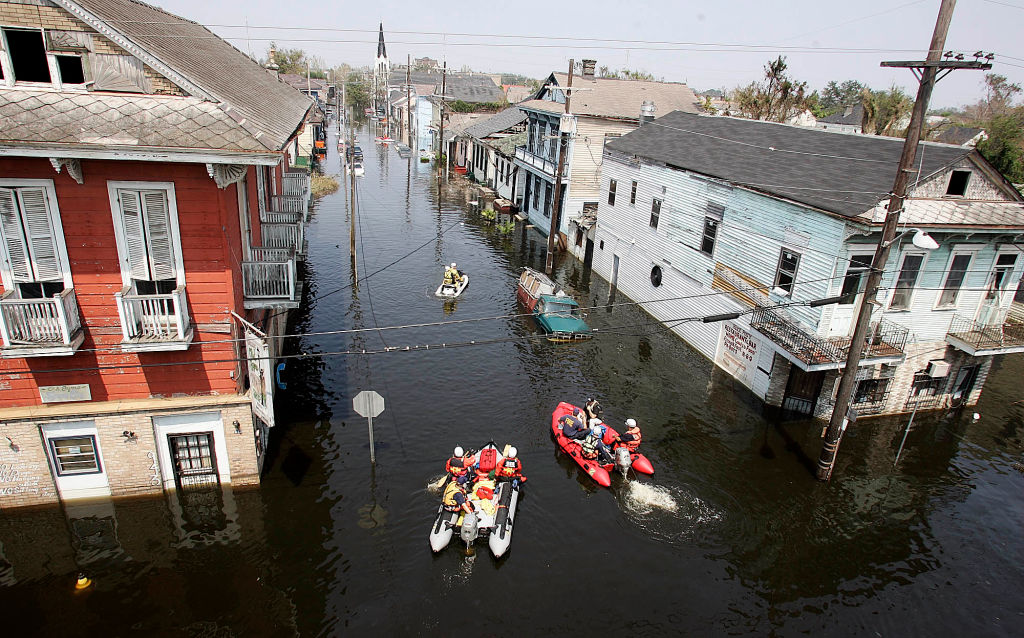Disasters were once considered an act of God—tragically inevitable in their devastation.
Then Hurricane Katrina happened in 2005, and the world watched as a man-made catastrophe unfolded. While the hurricane itself was a natural event, its impacts—destroying or severely damaging more than 1 million homes, displacing more than 1 million people, and causing at least 986 deaths in Louisiana—were not. Yet against all odds, New Orleans shows signs that it could become a beacon for innovative and cross-sectoral solutions for climate resilience, even as the federal government regresses in its own approach to disaster management.
[time-brightcove not-tgx=”true”]
August 29 marks 20 years since Hurricane Katrina devastated the Gulf Coast. As such, my team and I have been analyzing resilience in the New Orleans metro area, reflecting on two decades of recovery and progress since Hurricane Katrina.
New Orleans has made strides in restructuring institutions and developing a more diverse and entrepreneurial economy. The metro area has invested in new levies and changes to flood and other municipal water infrastructure that have reduced flood risks for many neighborhoods. The city has also drastically increased the rates of secondary education and internet access up to the national average, and fostered the development of new industries, including in health care and the performing arts.
All of these improvements have helped to make New Orleans as a city, and as a community, more resilient.
The most important lessons from Hurricane Katrina
This is not to say that there aren’t still substantial challenges for the region. New Orleans certainly isn’t perfect—in particular, the metro area is still not affordable or safe for all. Poverty rates are still far higher than the national average, job and wage growth have been slow, many residents still face disproportionate health burdens from petrochemical refinement, and wealth inequality along lines of race and income is still pronounced. Importantly, these challenges shouldn’t be interpreted as a lost cause. They’re an opening to work with residents to reimagine how the metro area could support communities to thrive in an unstable climate.
However, unlike in 2005, our national response to recent disasters is moving us backward, and making Americans less safe in the process. Whereas Hurricane Katrina led to sweeping changes in our national disaster management system that elevated the Federal Emergency Management Agency (FEMA) to a cabinet-level position and placed a greater emphasis on targeting social vulnerability in disaster response, the Trump Administration’s policies have included removing access to weather and climate data, firing meteorologists, and eliminating resources for building resilience. We’re slipping dangerously close to the old, pre-Katrina narrative: Disasters are a tragic but routine reality, and minimizing their impacts is an individual responsibility rather than a function of government.
Today, like in 2005, the unnaturalness of disasters is right in front of us: FEMA slow-walking disaster declarations in St. Louis after tornadoes ripped through low-income, Black-majority neighborhoods; officials ignoring calls from survivors after floods roared through Central Texas; and political sniping over water access rather than survivors’ needs taking center stage following the Los Angeles fires.
It seems that we’ve failed to learn the most important lesson from Hurricane Katrina. Yes, Katrina was a natural event, but its impacts were anything but. The worst effects of the storm weren’t solely borne by the residents living in the hurricane’s direct path, but by those already burdened by other social and economic challenges, such as the uninsured and those in rental precarity, families living in poverty, and people in poor health. These factors deepened the disaster’s impacts and elongated the recovery process.
How to build resilience
In many ways, our investigation of metropolitan New Orleans is a case study for building resilience in urban and rural communities across the U.S. Over the last 20 years, the climate has changed—literally. Today, a greater number of communities in a growing number of regions are more exposed to disasters than they ever have been in the past.
And these communities are also, for the most part, more socially and economically vulnerable. At a macro-economic level, income inequality has increased, poverty and rental precarity have risen, progress on indicators of racial equity such as the Black-white wealth gap has stalled.
Resilience is a concept that communities across the U.S. should be reaching for in our increasingly unstable times. The core of the idea is what you might imagine: the ability of a family or community to bounce back after a shock such as a hurricane or recession.
But there’s more to it. Resilience is about systems and their interaction—local economies and job markets, community organizations and civic safety nets, even ecosystems such as wetlands. The relationships between these systems—whether they positively amplify each other’s effects—determine a region’s resilience by creating a series of failsafes.
However, the most important aspect of resilience is the capacity for learning and transformation. A truly resilient community is one that fosters the ability to reduce disaster risks permanently, not just enable recovery back to the same pre-disaster state. Achieving such adaptation takes systems change, including developing new social and economic policies that can reduce costs for families and shore up access to essential services.
The impacts of Hurricane Katrina were deeply unequal on a scale unseen in prior tragedies, vividly demonstrating how inequities, including along lines of race and income, amplify disaster impacts and shape the disaster response and recovery process. The way New Orleans has invested in resilience since can serve as a much-needed reminder for how other disaster-prone cities across the U.S. should be preparing for extreme weather and disasters that climate change is amplifying.

